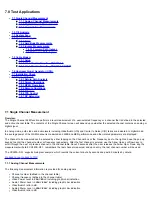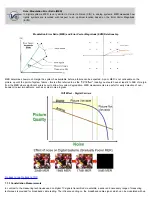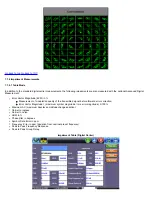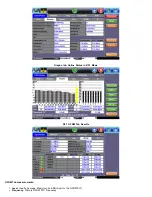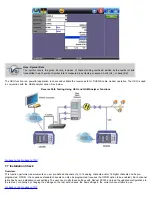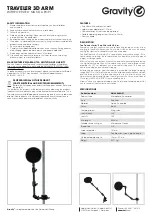
boundaries.
Start Frequency (MHz) and Stop Frequency (MHz)
The CX380S-D3.1 allows the entry of Start and Stop frequency in place of the CF and Span. The entry mode can be changed by
tapping on the CF or START icon. The entry range is from 5MHz to 1000MHz.
Zero Span
Zero Span mode is typically used for measuring the level variation of an analog channel. There are two ways to enter the
Zero Span mode:
Select CF of an analog channel and enter 0Hz for the frequency span, or
Select Start and Stop frequencies to be the same as the CF of an analog channel.
The display can be set for Linear or Log mode.
Vertical scale (dB)
Sets the logarithmic scale to 1, 2, 5, 7, or 10dB per division.
Resolution Bandwidth (kHz, MHz)
Selectable filter sizes (10kHz, 30kHz, 100kHz, 300kHz, 1MHz)
Resolution bandwidth is the bandwidth of the IF filter, which determines the selectivity of the spectrum analyzer. A wide
resolution bandwidth is required for wide sweeps, while a narrow filter is used for narrow sweeps.
The narrower the RBW setting, the better the frequency resolution; however, narrower filter settings require more
measurement time
Wider filters are used when the display needs to be updated rapidly, or when wide modulation bandwidths are to be
displayed.
Video Bandwidth (kHz, MHz)
The video bandwidth filters enable a form of digital averaging which helps to reduce signal variations caused by noise. Video
filtering, however, limits the speed at which the spectrum analyzer can scan.
Selectable filter sizes (10kHz, 100kHz, 1MHz)
Attenuation (dB)
To ensure that the input stages of the analyzer are not overloaded, an RF attenuator is used. If input stages are overloaded,
spurious signals may be generated within the instrument, resulting in possible false readings. However, if too much
attenuation is inserted, additional gain is required in the later stages (IF gain) and the background noise level is increased,
which can sometimes mask lower level signals. Thus, a careful choice of the relevant gain levels within the spectrum
analyzer is needed to obtain optimum performance Selectable attenuations is from 0 to 50dB in 5dB increments.
Sweep Time (ms)
The speed at which the analyzer scans the frequency span is important. The faster it scans the frequency range, the faster
the measurement can be made. However, the scan rate or dwell time of the analyzer is limited by IF filter (RBW) and the
video filter that may also be used to average the reading. These filters must have time to respond, otherwise signals will be
missed and the measurements rendered useless. Nevertheless, it is still essential to keep the scan rate as high as is
reasonably feasible to ensure that measurements are made as quickly as possible.
Selectable sweep times are 30, 50, 100, 150, 200, 250, 300 and 1000ms. For a larger span due to the amount of
sampling points data to be taken, the sweep time will adjust automatically to a longer period.
Marker
There are 4 markers available -- two verticals and two horizontal. They can be activated by tapping the MARKER function
key.
Signal levels, frequencies and deltas are displayed with color coding.
To move a marker, tap on the Circle associated to each marker. For fine tuning of the marker, use Up, Down, Left, and
Right arrow keys.
Vertical and horizontal markers can be paired and be moved together.
Search
The Peak or Min or both in the measured span can be searched automatically. The search is updated per sweep.
Peak-Left and Peak-Right functions functions for Peak Search allow configurable peak level thresholds. A blue horizontal line
appears on the screen when Peak Left (Pk-Pk Left) or Peak Right (Pk-Pk Right) is pressed, indicating the peak level
threshold. This can be moved to the desired threshold by tapping on the dot at the end of the line and moving it.
Min/Max Hold
Minimum, Maximum or both per sweep are detected and held at their location in the spectrum analysis mode.
The Min is shown in BLUE color and Max is in RED.
By tapping the UPDATE function key, the current spectrum, in YELLOW color can be shown together with the Min/Max or
removed.
Profile
For repeated use of the same spectrum analysis settings, user can tap on the PROFILE function key and save the current
settings in a profile or recall a pre-stored setting for a list up to 20 profiles by name.
Auto Attenuation (AUTO ATTN.)
Auto attenuation, upon activating, searches for the peak within the span and automatically set the attenuation such that the
peak of the signal is placed at about 15dB to 20dB below the top of the display. Please note that auto attenuation will set the
VScal (Vertical Scale) to 10dB by default.
Burst QAM
Burst QAM mode is a unique feature in the CX380S-D3.1 family. The feature is useful for detecting and displaying the burst
or transient QAM signal generated by the Cable Modems in the return path. The Burst QAM mode is similar to Peak Hold but
only holds the peak for 5 consecutive scans for easy identifying of a Cable Modem channel in the return path.
Summary of Contents for VEPAL CX350S-D3.1
Page 1: ...CX350s D3 1 e Manual D07 00 102P RevA01 Page 1 of 109 ...
Page 13: ...Go back to top Go back to TOC CX350s D3 1 e Manual D07 00 102P RevA01 Page 13 of 109 ...
Page 16: ...Go back to top Go back to TOC CX350s D3 1 e Manual D07 00 102P RevA01 Page 16 of 109 ...
Page 21: ...Go back to top Go back to TOC CX350s D3 1 e Manual D07 00 102P RevA01 Page 21 of 109 ...
Page 57: ...Go back to top Go back to TOC 7 8 4 Remote Operations ...
Page 76: ...Go back to top Go back to TOC CX350s D3 1 e Manual D07 00 102P RevA01 Page 71 of 109 ...


